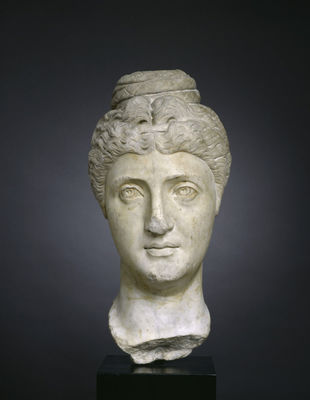
Description
This marble head depicts Faustina the Elder, a celebrated Roman matron and wife of Emperor Antoninus Pius. One of the first things you probably noticed about this sculptural head is the milky whiteness of Faustina’s skin, rendered in pure marble. While we often associate classical sculpture with white marble, sculptures and buildings were actually painted in bright colors. You can imagine how this already lifelike face must have come alive when painted to more closely resemble the subject, Empress Faustina. When Faustina died at the early age of 40 in 141 CE, her devoted husband honored her with deification, essentially making her a goddess.
Faustina epitomizes the attributes of the ideal Roman woman: beauty, elegance, traditionalism, and the maintenance of marital harmony. Images of Faustina the Elder are identifiable by her unique hairstyle, which is interwoven in the back, and piled high in braids at the top of her head. Elaborate hairstyles were not just fashionable in ancient Rome; they could also be important political and social statements. For instance, many Roman women adopted Faustina’s imperial coiffure in an attempt to publicly represent themselves as possessing the same virtues as the admirable empress.
Details
- Work Date:
- Second half of the 2nd century CE
- Location:
- Evans Gallery
- Dimensions:
- Overall: 17 1/8 in x 7 3/4 in x 9 3/4 in; 43.5 cm x 19.7 cm x 24.8 cm; Base: 7 1/4 in x 6 in x 6 in; 18.4 cm x 15.2 cm x 15.2 cm